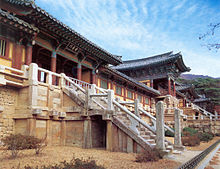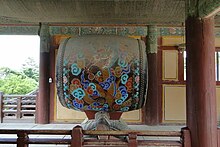Bulguksa
| Korean alphabet : | 불국사 |
| Hanja : | 佛 國寺 |
| Revised Romanization : | Bulguksa |
| McCune-Reischauer : | Pulguksa |
Bulguksa is a Buddhist temple in Gyeongsangbuk-do Province in South Korea and is located 16 kilometers southeast of the city of Gyeongju , the former capital of the Silla Kingdom. The temple is considered a masterpiece of the heyday of Buddhist art in the Silla Kingdom. It is home to seven national treasures of South Korea: two stone pagodas, two staircases, two gold-plated Buddha statues and a reliquary.
history
In the year 528 King Beopheung erected a small prayer temple for his wife on this site, which later fell into oblivion and fell into disrepair. The present temple was started under King Gyeongdeok by his Prime Minister Kim Dae-seong and was completed in 774. At that time the temple was named Bulguksa (Temple of the Land of Buddha).
It was renovated several times during the Goryeo and early Joseon Dynasties . However, during the Imjin War (1592–1598) the wooden buildings burned down completely. The rebuilding and enlargement of the temple complex began as early as 1604 and in the following time there were further renovations, but there were also repeated destruction and looting.
After an extensive archaeological investigation, the Bulguksa was finally extensively reconstructed under President Park Chung-hee between 1969 and 1973 and received its present appearance. The famous stone constructions could be preserved and date from the Silla period.
In 1995 the temple complex, together with the Seokguram grotto located 2 km uphill, was included in the UNESCO World Heritage List under the title Seokguram Grotto Temple and Bulguksa Temple .
architecture
The former main entrance of the temple complex led via a two-part staircase through the "Gate of the Purple Fog" (Jahamun) to the large temple courtyard.
The staircase has 33 steps. They symbolize the 33 steps to enlightenment and are made of cut granite blocks. The staircase dates back to the 8th century and is Korea's National Treasure No. 23. The lower part, the "Bridge of Blue Clouds" (Cheongungyo), is 6.3 m long and has 17 steps. The upper part, the "bridge of the white clouds" (baegenyo), is 5.4 m long and has 16 steps. The ascent via the two stone stairs has been blocked. Today visitors enter the temple courtyard behind the Jahamun Gate via a side entrance.
In the middle of the large temple courtyard is the “Hall of Great Enlightenment” (Daeungjeon). It was completely destroyed during the Imjin War (1592–1598), the current hall is a modern reconstruction.
There are two stone pagodas on the square between Jahamun Gate and Daeungjeon Hall: the simple three-tier Seokgatap and the intricately constructed Dabotap.
The Seokgatap Pagoda is 8.20 m high. Three floors rise on a square base with the downward-facing staircase of the roof crowns typical of Silla. The Seokgatap is over 1,300 years old and is Korea's National Treasure No. 21.
The extraordinary Dabotap Pagoda, Korea's national treasure no. 20, is approx. 10.40 m high and is one of the most important Buddhist works of art in the world. The lowest part of the pagoda is formed by a cuboid, which embodies the earthly yin principle. There are four nine-step staircases on this. There are four massive corner pillars and a central heart pillar on the ashlar. These support a square roof panel with a fence. Above this roof plate, the pagoda merges into a complicated octagonal crown. The octagon symbolizes the circle, which embodies the heavenly Yang principle. The Dabotap Pagoda is depicted on the current 10 won coin.
The rear of the large temple courtyard is closed off by the “Hall without Words” (Museol-Jeon). The name of the hall goes back to the fact that Buddha's faith cannot be taught with just words. It is the largest hall in the complex and, like the Daeungjeon Hall, is a modern reconstruction.
To the north, behind the Museol Jeon Hall, there are two more halls. On a hill in the northeast, the highest point of the complex, lies the Kwaneum Jeon Hall with a picture of Avalokiteshvara and in the northwest the Biro Jeon Hall with a statue of Vairocana Buddha. This statue is 1.77 m high and made of gilded bronze. It probably dates from the 9th century and is Korea's national treasure no. 26. In front of the Biro Jeon Hall is national treasure no. 61: the sarira stupa, a reliquary in the form of a stone lantern.
To the west of the large temple courtyard is another, smaller temple courtyard. This one used to be reached via another two-part staircase, which is now also blocked. This is smaller overall, but resembles the larger system in shape and structure. It has 18 steps and is Korea's National Treasure No. 22. The lower part, the "Bridge of the Lotus Flower" (Yeonhwagyo), has 10 steps and the upper part, the "Bridge of the Seven Treasures" (Chilbogyo), has 8 steps. This staircase led through the “Gate of the Pure Land” (Anyangmun) to the small temple courtyard with the “Paradise Hall” (Geungnakjeon). This contains Korea's National Treasure No. 27, a gilded bronze statue of Amitabha Buddha. The statue is 1.66 m high and probably also dates from the 9th century.
Web links
- Official Homepage Bulguksa (Korean)
- Pictures, site plan, brief description (English)
- Entry on the UNESCO World Heritage Center website ( English and French ).
Coordinates: 35 ° 47 ′ 24 ″ N , 129 ° 19 ′ 56 ″ E





